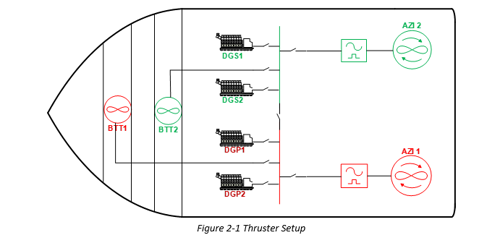Vessel degraded capability
- DP Event
- Published on 27 January 2023
- Generated on 15 December 2025
- DPE 01/23
- 4 minute read
Incident
Jump to:
Commercial pressures maybe at play... Has the vessel been given enough time within the contract to carry out routine maintenance?
Overview
A PSV was conducting DP operations in an open bus 2-way configuration. The vessel had two redundant groups, each with two generator and two azimuth thrusters.
The Worst Case Failure Design Intent (WCFDI), was stated in the FMEA as:
"No single failure as defined for notation XXX will have a greater effect on the vessel’s ability to maintain position than the loss of one switchboard (REDUNDANT GROUP), resulting in loss of two thrusters (one fwd and one aft) and two generators. This design intent applies when the power plant is configured as two independent power systems. This design intent applies when each of the two power systems has generators connected."
The Worst Case Failure (WCF) identified from analysis of the DP system on the vessel is loss of the port engine room due to an auxiliary failure, this would cause the loss of the two generating engines, Switchboard, Azi 2 & BTT1, with BTT1 being the most forward thruster.

Observations
As demonstrated during the DP FMEA Proving Trials and subsequent Annual DP Trials, the vessel is effectively capable of losing one of the two redundant groups after a single failure. The vessel will then be able to maintain its heading and position within the remaining in-tact redundant group.
At the time of this particular operation there were deficiencies within both of the redundant groups:
- Azi 1 had hydraulic issues on the azimuth circuit which meant it was required to be in ‘Fixed’ DP Control mode.
- BTT2 was very sluggish in following the DP Command and was continually activating feedback alarms.
- Due to a leaking turbocharger, Generator DGP2 was only to be used in an emergency, and if used, not to exceed 50% power.
All shore support personnel and vessel personnel were aware of the problems, but the client was unaware. Regardless, the vessel continued to operate in the vicinity of stationary structures.
Conclusions
The vessel is degraded in its intact and post failure capability, and is no longer single fault tolerant.
If the Port redundant group fails, the vessel will be left with a subpar bow thruster that could be lost from DP Control at any time.
If the Starboard redundant group failed, the vessel would be left with a subpar azimuth thruster that could be rejected by DP Control at any time. The port redundant groups generating capacity is severely constrained because there is no confidence in DGP2’s ability to supply adequate power.
An in-depth evaluation could have been performed to determine post-failure capability, resulting in an update to ASOG. This would ensure client transparency, and DPOs would be fully aware of the vessel’s reduced capability.
Additional comments
Commercial pressures maybe at play from both the vessel owner and client – Has the vessel been allotted enough time within the contract to carry out routine maintenance?
- Vessel crews should use decision support tools, such as the ASOG to manage station keeping risk.
- Vessel crews and managers should have a full understanding of their vessel’s redundancy concept, post failure DP capability and the performance requirements following the worst case failure.
- Vessel crews and managers should be aware that when 100% power is not available from a single bus or generation of a group, the ASOG power limits and thruster percentage limits should be reduced to maintain WCFDI.
- The purpose of field arrival trials is to ensure satisfactory operation of the DP system. The checks should include full functional checks of the operation of the thrusters, power generation, auto DP and IJS and manual controls.
Latest DP incidents
-
Always be prepared – Erroneous relative GPS heading input jeopardises follow target operations
Always be prepared – Erroneous relative GPS heading input jeopardises follow target operations
DPE 02/25
1 August 2025
Incident
-
Printer compatibility
This undesired event occurred on a DP Class 3 drillship, whilst operating in open bus configuration and undertaking drilling operations.
DPE 02/25
1 August 2025
Undesired event
-
Inadvertent act causes loss of DP, once again!
While vessel was recovering scrap metal using an ROV and crane, an alarm was triggered, but the DPO could not silence it
DPE 02/25
1 August 2025
Incident
-
Beware the solitons
An equipment class 2 pipelay vessel was engaged in pipelay operations in an area known for solitons
DPE 02/25
1 August 2025
Undesired event
-
DP drill scenario
DP emergency drill scenarios are included to assist DP vessel management and DPOs / Engineers and ETOs to conduct DP drills onboard.
DPE 02/25
1 August 2025
Drill Scenario
The case studies and observations above have been compiled from information received by IMCA. All vessel, client, and operational data has been removed from the narrative to ensure anonymity. Case studies are not intended as guidance on the safe conduct of operations, but rather to assist vessel managers, DP operators, and technical crew.
IMCA makes every effort to ensure both the accuracy and reliability of the information, but it is not liable for any guidance and/or recommendation and/or statement herein contained.
Any queries should be directed to DP team at IMCA. Share your DP incidents with IMCA online. Sign-up to receive DP event bulletins straight to your email.